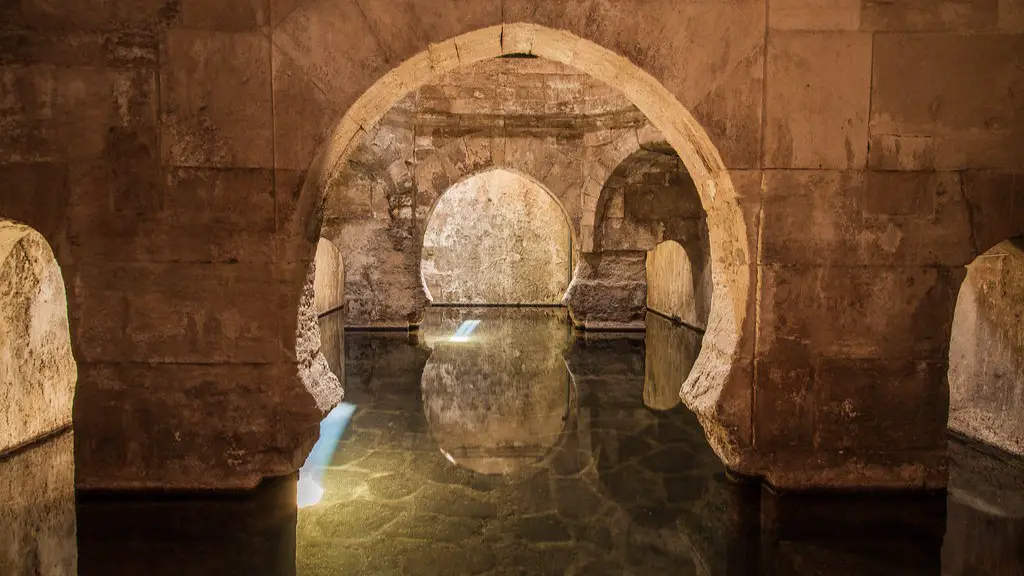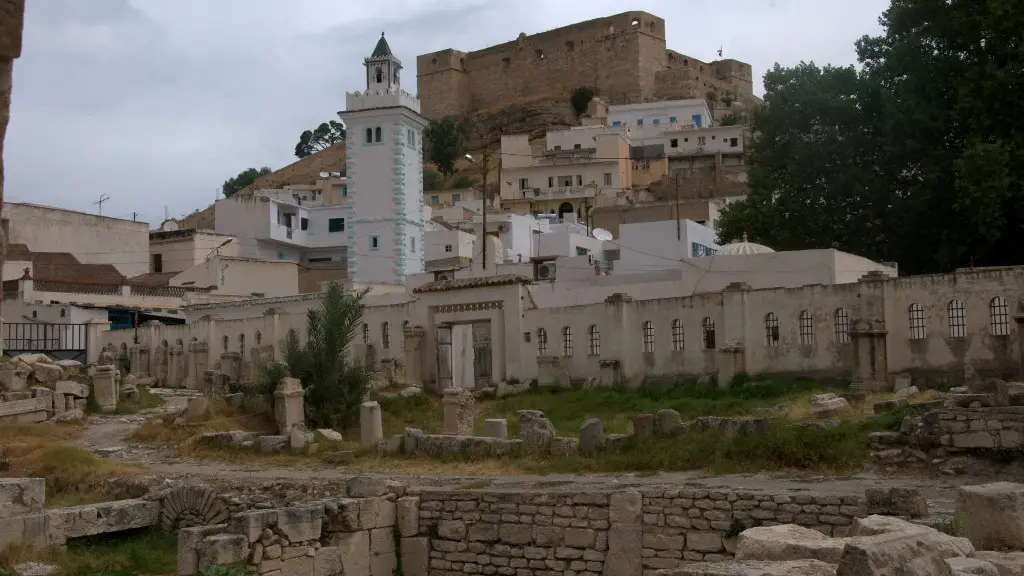The ancient Roman civilization is renowned for its innovative and highly influential contributions to architecture and engineering, particularly in the fields of military, politics and religion. As part of this, the Romans also pioneered advances in sleeping arrangements, which have gone on to shape and influence the sleeping arrangements used across the world today. This article aims to explore the innovative sleeping arrangements used by the Ancient Romans, as well as why and how they came about.
Living in the warm Mediterranean climate, the Roman citizens – particularly those of a higher order – typically slept in beds placed on slatted frames in order to keep the mattress from getting overly hot. This was known as a lectus, a Latin term derived from the verb “to lie down”. It was important to keep the mattress airy to avoid mites, a major problem at the time. It was not uncommon to use non-permeable sheet like canvas and hair instead of cloth to keep the bedding warm and safe.
The mattress had a layer of filling and was generally made of wool, down, feathers or a combination of all three. Wool was used due to its natural properties, providing cushioning and heat retention. Down and feathers were used for their softness and insulation. While beds of this type have gone out of fashion, it was only in recent times that polyester fiber has become popular as an alternative filling material.
As well as the lectus, Ancient Romans had a deerskin (feathered) rug mounted on a frame for extra insulation. Fur was used mainly for its aesthetic value, but it was also believed to ward off minor illnesses associated with mites and bad air. Fur was also important for its warming properties and its ability to absorb moisture.
Though fur was used mainly for its aesthetic properties, it was also believed that it gave spiritual remedy to sleep as well as having hygienic/sanitary benefits. The fur itself was indicative of riches and power. This can be seen in the distinction between Roman citizens and nations of a lower status who did not enjoy the fur bedding.
In addition to fur and lectus, many Roman beds included curtains to protect the occupant from the outside elements, as well as a canopy to keep away insects.
The Ancient Romans also included pillows and bolsters but saw these as functional items, not just nice additions. Pillows, often stuffed with wool or down, offered extra support and comfort, while bolsters were seen to improve sleep posture.
The Erotic Sleeping Habits of Ancient Romans
It is important to note that Romans embraced nudity and often slept nude or partially nude. This was seen as sexual and erotic rather than just preferring to be comfortable, and historians have suggested it may have been a sign of increased power and wealth. That said, it certainly appears that comfortable and pleasurable sleeping was a priority for the Romans.
Unusually for the time, the Ancient Romans did not demand couples to sleep in separate beds. Instead, sexual intercourse was seen as a physical and intimate act to be enjoyed within the bedroom, while cuddling and embracing in bed were also believed to be important.
Also of note, Ancient Romans were believed to have placed sleeping with partners in high regard, with sleeping together becoming a status symbol. This helped to facilitate the sharing of body heat, which was seen as being beneficial by the Romans. It was thought to not only provide comfort and enhance intimacy but also ensure sound sleep, with the complete absence of night-terrors.
As well as sharing warmth, the Romans believed that sleeping together fostered friendships and improved relationships in general. This helped to strengthen social ties in the empire and arguably helped to establish the Roman Empire as one of the most successful and powerful empires in the world.
Ancient Roman Travel Options
Apart from sleeping in their home, the Ancient Romans often had to travel. When they did, they liked to sleep in easily portable beds, such as triclinia – three-sided portable beds – and curule, which were usually placed on the floor. The triclinia could easily be folded and carried with you, and at night the bed would be opened for sleeping.
Triclinia provided a comfortable sleeping solution for Romans, who often used them during their travels or when visiting friends and family. When used in this way, the beds featured a set of footstools for extra support. As well as being suitable for sleeping, the triclinia could also be used during mealtimes, with guests reclining on them while eating from low tables.
Curule beds were similar to triclinia, except they were a single mattress rather than a three-sided bed. They were a comfortable, lightweight option, often featuring a thin quilt and blankets, and easily portable. Because of this, they were often used when travelling, as well as by soldiers when on the move.
Another important sleeping solution for the ancient Romans was the tramez, a single bed on either a wooden or marble base. This was generally nowhere near as comfortable as the triclinia or curule beds but it did offer the benefit of being a more permanent option. This kind of bed was particularly popular in military camps, where accommodation needed to be robust and reliable.
Roman Bedding Options
The ancient Roman bedding was highly advanced for its time and made use of a variety of materials and fabrics for different purposes. Sheepskin and wool were used for insulation, whilst tightly woven linen was used for its breathability. Fur was also quite popular, both for aesthetic reasons and for its ability to retain body heat.
Linen and wool blankets provided further warmth and comfort, with some beds featuring a blanket of soft linen over the mattress and an additional top layer of wool. In addition, some blankets were decorated with embroidery, giving them a more luxurious feel. These often featured various motifs and designs and it is thought that they were used to identify the beds of aristocrats.
Bed linen was typically made of linen – and rarely of wool – but it could vary depending on the wealth of the household. Often, Romans would own a number of sheets, which not only made sleeping more comfortable but also provided protection against bedbugs, sweat and other forms of skin diseases. Finely woven cotton sheets also emerged for the wealthier citizens, though these were not particularly common.
The Hygienic Sleeping Habits of Ancient Roman Citizens
Not only did Ancient Roman citizens pay attention to hygiene when it came to sleeping arrangements, but they also had some of the most advanced toilets in the world at the time. Toilets consisted of a hole in the ground with a seat, onto which water was poured for flushing. Sewers were also constructed to flush away waste from multiple sites in the city.
The Ancient Romans were also very clever in the way they constructed their sleeping arrangements. For example, pillows were placed on top of headboards to help prevent dust mites. They also used a sealant made of beeswax to block bedbugs and other insects. The use of beds on wooden frames was also key in keeping the environment clean and hygienic.
Bathrooms played an important role in helping to prevent skint ailments. Versions of baths used by the Romans are still used today, with the audience hypocaust being one of the most notable. This was a system which heated steam rising from the floor of the room, helping to keep the air warm, ventilated, and free from any allergens.
Ancient Roman Bedtimes and Daytimes
Ancient Roman citizens typically changed into their nightwear before bed, usually consisting of a long sleeved white linen shirt. Prior to the modern invention of electric lighting, bedtimes were determined by the sun and its patterns, with people rising at dawn and sleeping shortly after dark.
However, that said, Ancient Romans were very innovative and were some of the first people to experiment with artificial lighting, or circadian lighting. This involved lighting during the night to extend the day, enabling lives to become less limited by nightfall.
A well-known example of this was the use of fire lamps, derived from the Assyrians, which were hung from hooks in the walls. With specially made oil lamps lighting up the home, families could stay up late into the night and rise later in the morning without interruption from insect swarms or the setting or rising of the sun.
The Representation of Ancient Roman Bedrooms
Recent archaeological evidence has greatly aided our understanding of how bedrooms were represented in Ancient Roman culture. Paintings of cupids, gods, prophecies and a variety of scenes were popular, along with vibrant colours which were thought to offer a sense of protection against negative influences.
Similarly, reliefs were often added to provide a ‘magical’ feeling and were thought to both protect and comfort the sleeper. Useful everyday objects, such as cushions and shoes, were also popular sources of decoration in Ancient Roman bedrooms.
The inclusion of mirrors in the bedroom was also commonplace and believed to ward off evil spirits, as well as providing light, whilst tapestries were often hung to limit the movement of insects in the bedroom. Similarly, mattresses and coverings were often decorated with floral images, as these were seen as pleasing to the eye.
All of this and more have gone on to shape and influence sleeping arrangements used across the world today, with many of the Ancient Roman ideas, materials and designs still in use.
The Influence of Ancient Roman Sleeping Arrangements
As mentioned, sleeping arrangements of Ancient Rome have gone on to shape and influence sleeping arrangements used across the world today. Their innovation, experimentation and desire to provide comfort, luxury and hygiene was incredible ahead of its time and it is clear that many of their principles and materials can still be seen in use.
The Roman citizens, particularly those of higher order, embraced outdoor sleeping during the heatwave months and inside sleeping during the winter. This formed part of a complete approach to their bedding and sleeping arrangements which had both practical and luxurious purposes.
The rise in popularity of sleeping in beds, the inclusion of pillows, bolsters and other types of bedding, as well as intricate bed-frames and decorations, have all been highly influential and have gone on to shape sleeping arrangements as we know them today.
In particular, Romans’ use of wooden frames with permeable sheet materials, showed a great level of foresight and awareness of the need to keep mattresses aired and ventilated, and this remains a popular approach today. Similarly, the advent of synthetic fabrics for bedding and the inclusion of pillows for extra comfort have endured since the Ancient Romans.
Summary of Where the Ancient Romans Slept
The Romans embraced nudity, slept together as couples, and used different sleeping arrangements depending on the season. They made use of fur, wool and down as mattress fillers, whilst also experimenting with various fabrics like linen and wool to provide insulation and comfort.
Furthermore, the Romans employed intricate decorations, such as paintings of gods, cupids, reliefs, and fire lamps; as well as the presence of mirrors, to create both a desirable and protective atmosphere. The beds were placed on slatted frames and had pillows and bolsters for added comfort and auxilary support.
The Ancient Romans have left a lasting legacy when it comes to sleeping arrangements, providing many of the principles and materials that have gone on to shape and influence sleeping arrangements used across the world today.





